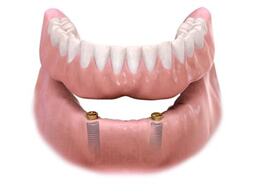
An overdenture is a type of denture designed to go over the teeth or dental implants. It is attached by specialized dental attachments that are secured in the roots or implants.
Overdentures are often worn by edentulous patients, patients who have lost all of their teeth. A complete set of dentures can be uncomfortable and feel unnatural, while overdentures are often a good option if the patient still has teeth roots.
Over-dentures will be designed to fit over teeth or dental implants.An overdenture uses instruments that fasten it to the jawbone. This procedure mimics the way that natural teeth are held in place. One type of overdenture requires the use of bar joints to support the dentures and the surrounding teeth, which often have to be adjusted to make room for the overdentures. Bars on the upper arch of the jaw need more implants than those on the lower arch because there is less bone density in the upper jaw.
Bar joint overdentures are fixed full dentures that become a permanent part of the patient’s mouth. They are screwed into overdenture implants and surgically inserted into the bone, where the denture becomes anchored. Since they are fixed firmly to the teeth, these implant overdentures make chewing and tearing of almost any type of food as easy as with regular teeth.
The most important health benefit of an overdenture is the prevention of bone loss, as the implant overdenture strengthens the bone structure. Of course, dentures look nicer than a mouth of gums and no teeth. The patient also experiences a much easier time talking and eating with overdentures. If inserted properly, an overdenture should align the jaws accurately and restore 90 percent of chewing power to the patient. Better oral hygiene and decreased risk of gum disease are two additional advantages of using overdentures.
Plano Smile Studio 2023® All Rights Reserved.